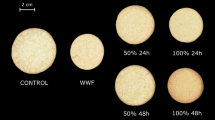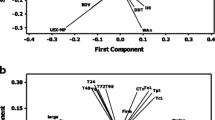Abstract
White salted noodles were prepared from reconstituted flours of various amylose content to determine the effects of amylose content on noodle dough properties and texture of noodles cooked for optimum cooking time. With decrease of amylose content from 26.5 to 3. 0%, optimum water absorption of noodle dough increased from 39 to 49% and cooking time of noodles decreased from 16 to 7 min. Hardness of cooked noodles prepared from reconstituted flour consistently decreased with increase in proportion of waxy starch. Noodles less than 12.4% amylose content exhibited higher springiness and cohesiveness than noodles greater than 17.1% amylose content. Cohesiveness and springiness of noodles prepared with partial waxy starches, of which amylose content ranged from 16. 6 to 22. 7%, were comparable to those of noodles prepared from <12. 4% amylose content. Amylose content of starch was significantly correlated with hardness, springiness, and cohesiveness of cooked noodles prepared from reconstituted flours.
Similar content being viewed by others
References
Oh NH, Seib PA, Ward AB, Deyoe CW. Noodles. IV. Influence of flour protein, extraction rate, particle size, and starch damage on the quality characteristics of dry noodles. Cereal Chem. 62: 441–446 (1985)
Konik CM, Miskelly DM, Gras PW. Contribution of starch and non-starch parameters to the eating quality of Japanese white salted noodles. J. Sci. Food Agr. 58: 403–406 (1992)
Baik B-K, Czuchajowska Z, Pomeranz Y. Role and contribution of starch and protein contents and quality to texture profile analysis of oriental noodles. Cereal Chem. 71: 315–320 (1994)
Park CS, Hong BH, Baik B-K. Protein quality of wheat desirable for making fresh white salted noodles and its influence of processing and texture of noodles. Cereal Chem. 80: 297–303 (2003)
Moss HJ. The pasting properties of some wheat starches free of starch damage. Cereal Res. Commun. 8: 297–302 (1980)
Oda M, Yasuda Y, Okazaki S, Yamauchi Y, Yokoyama Y. A method of flour quality assessment for Japanese noodles. Cereal Chem. 57: 253–254 (1980)
Crosbie GB. The relationship between starch swelling properties, paste viscosity, and boiled noodle quality in wheat flours. J. Cereal Sci. 13: 145–150 (1991)
McCormick KM, Panozzo JF, Hong SH. A swelling power test for selecting potential noodle quality wheats. Aust. J. Agric. Res. 42: 317–323 (1991)
Konik CM, Miskelly DM, Gras PW. Starch swelling power, grain hardness, and protein: Relationship to sensory properties of Japanese noodles. Starch 46: 292–299 (1993)
Graybosch RA. Waxy wheats: Origin, properties, and prospects. Trends Food Sci Tech. 9: 135–142 (1998)
Yasui T, Matsuki J, Sasaki T. Matsuki J. Milling and flour pasting properties of waxy endosperm mutant lines of bread wheat (Triticum aestivum L.). J. Sci. Food Agr. 79: 687–692 (1999)
Abdel-Aal ESM, Hucl P, Chibbar RN, Han HL, Demeke T. Physicochemical and structural characteristics of flours and starches from waxy and nonwaxy wheats. Cereal Chem. 79: 458–464 (2002)
Chao S, Sharp PJ, Worland AJ, Warham EJ, Koebner RMD, Gale MD. RFLP-based genetic maps of wheat homoeologous group 7 chromosomes. Theor. Appl. Genet. 78: 495–504 (1989)
Nakamura T, Yammamori M, Hirano H, Hidaka S. Identification of three Wx proteins in wheat (Triticum aestivum L.). Biochem. Genet. 31: 75–86 (1993)
Nakamura T, Yamamori M, Hidaka S, Hoshino T. Expression of HMW Wx protein in Japanese common wheat (Triticum aestivum L.) cultivars. Jpn. J. Breed. 42: 681–685 (1992)
Yamamori M, Nakamura T, Endo TR, Nagamine. Waxy protein deficiency and chromosomal location of coding gene in common wheat. Theor. Appl. Genet. 89: 179–184 (1994)
Miura H, Tanii S. Endosperm starch properties in several wheat cultivars preferred for Japanese noodle. Euphytica 72: 171–175 (1994)
Baik B-K, Lee MR. Effects of starch amylose content of wheat on textural properties of white salted noodles. Cereal Chem. 80: 304–309 (2003)
Park CS, Baik B-K. Cooking time of white salted noodles and its relationship with protein and amylose contents of wheat. Cereal Chem. 81: 165–171 (2004)
Czuchajowska Z, Pomeranz Y. Protein concentrates and pure starch from wheat flours. Cereal Chem. 70: 701–706 (1993)
AACC. Approved Methods of the AACC. 10th ed. Method 08-01, 38-10, 44-15A, 46-30, 54-40A, and 66-50. American Association of Cereal Chemists, St. Paul, MN, USA (2000)
Williams PC, Kuzina FD, Hlynka I. A rapid calorimetric procedure for estimating the amylose content of starches and flours. Cereal Chem. 47: 411–420 (1970)
Oh NH, Seib PA, Chung DS. Noodles. V. Determination of optimum water absorption of flour to preprare oriental noodles. Cereal Chem. 63: 93–96 (1985)
Nagao S, Ishibashi S, Imai S, Sato T, Kanbe Y, Otsubo H. Quality characteristics of soft wheats and their utilization in Japan. II. Evaluation of wheats from the United States, Australia, France, and Japan. Cereal Chem. 54: 198–204 (1977)
Park CS, Baik B-K. Significance of amylose content of wheat starch on processing and textural properties of instant noodles. Cereal Chem. 81: 521–526 (2004)
Toyokawa H, Rubenthaler GL, Powers JR, Schanus EG. Japanese noodle qualities. II. Starch components. Cereal Chem. 66: 387–391 (1989)
Author information
Authors and Affiliations
Corresponding author
Rights and permissions
About this article
Cite this article
Heo, H., Baik, BK., Kang, CS. et al. Influence of amylose content on cooking time and textural properties of white salted noodles. Food Sci Biotechnol 21, 345–353 (2012). https://doi.org/10.1007/s10068-012-0046-9
Received:
Revised:
Accepted:
Published:
Issue Date:
DOI: https://doi.org/10.1007/s10068-012-0046-9




